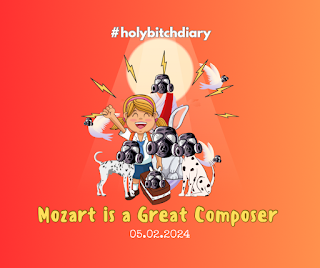Holy Bitch Diary: January 24th, 2024.
📖January 24th, 2024
🦈If we dive deeper into the history of the fascism, Germany probably was the one of the latest countries in the world, which got the seeds of this concept. The notable fact about the so called eugenic theory of human breeding, the sound component of which was the human heap leaching to extract the valuable gold from the empty rock, is that the eugenic was not invented by people who possess the relevant knowledge in the field of biology, genetics, medicine. The eugenic concept in its form which we know now, it was invented by the British psychologist, in the last third of the 19th century, alongside with the preparation for the word war. Thus, the human breeding concept was not invented pursuing the academic purposes, and its fundamentals concern the objective to get the "academic proof" of the policy, which the initiators of the war conflict intended to exploit to achieve their targets: roughly speaking, for the propaganda shifting the focus of the massive attention to the absolutely different topic from the main targets of the fascists. On the history of the fascism timeline, the its beginning starts from the beginning of the human kind.
However, to discover the whole story is impossible without defining the conceptual watershed. What is the fascism is not the rethoric question. It is the main question that allows to understand and discover it. The definition itself, has the root in the word fascio - the brotherhood. The fraternity as a form of the organization got the widest distribution throughout the religious sects, and obtained a renaissance later, in the USA, in form of fraternities across many educational organizations.
Griffin (2017) states, that "the concept of the fascism seems to be simple and clear for everyone, until you offer this everyone to explain what fascism is." Eagleton (1976) argued, that "fascism is once more a real political issue in the advanced capitalist societies; and some historical analysis of its constitutive structures is absolutely indispensable to the political task of rooting it." As per Eagleton, "fascism is essentially the attempt to ensure the rule of monopoly capitalism in its purest, most untrammelled, most invulnerable form." Thus, the concept of the fascism initially does not have the human breeding as the basics of its ideology. It is a political tool of economic nature. It is crucial for the understanding of the WWII and its sequels demonstrated to us.
Paxton (1998) believes, that the major difficulties stand in the way of any effort to define fascism are timing, mimicry, and "the dauntingly wide disparity among individual cases in space and in time, the ambiguous relationship between doctrine and action." Kogan (1969) states, "The label fascism, and the epithet fascist, have been applied to number of regimes and individuals who vary widely in their so origins, their goals, their behavior before reaching power, and deeds after they obtained power." Bauer (1881-1938) defined the fascism as "a paramilitary construction divided over their respective attitudes towards the Catholic Church and the foreign policies." Thus, the obvious traces of the connection between the fascism organizations and the Vatican were noted even in academic literature.
The visual spatial language was the cornerstone of the 3rd Reich military operations. However, this communication manner was credited from the inventor of the most intelligent communicating rituals - religious organizations, and, in particular, the Roman church. "A striking feature of that life which is not illuminated by such techniques is a highly developed sense of pageantry, even showmanship, amply documented and expressed over a wide range of solemn occasions in ceremonial and magisterial regalia. This high sense of the dramatic in public life found expression in the rituals and displays of a dynamic state-emblems which were demonstrably charged with emotion." (Marshall, 1984). Fuentes (2017) noted: "Overcoming liberal language meant not only setting up new political terminology, but also replacing words with symbols, ideas with sensations. This is why the standard political lexicon of totalitarianism became hardly more than a slang vocabulary for domestic consumption and, by contrast, under those regimes - mainly Italian fascism, Nazism, and Stalinism - a flamboyant universe of images, sounds, metaphors, body language." The symbolic language destroying the words as a way of verbal communication, actively exploited by the criminal organizations of totalitarian nature, including religious sects. Paulicelli (2010) wrote, that during the post-war time, "Rome projected a new image of glamour, art, and beauty, a symbol of the economic miracle as a result of the reconstruction due to the rich and multifaceted exchanges between Italy and America, and the new identity shaped through American mediation." The visual communication is broadly used for the two main reasons. First, to avoid leaving the traces in verbal language and keep the anonymity (as long as the visual-spatial language was not recognized by the courts as an official language yet). The second one, which is more important, is that the human brain does not have the protection of the image, and immediately processes it. The written words, the human brain can easily ignore or interpret distorting the sense, visual image goes immediately to the brain for the decoding, and this communication is much faster than the written explanation.
Thus, the unity of the fascism's definitions does not exist because nobody can't formulate it, arguing about its nature based on the judgment, intuition, and evaluative understanding of this phenomena. The explanation is obvious - the fascism does not use the verbal communication, aggressively exploiting visual-spatial language. It is the reason, why most of us can feel what fascism is, but can't give the precise and complete definition of it using the verbal language. Meanwhile, the definition can be easily figured out by summarizing the nature of the main fascism attributes, which are described in academic literature. Fascism is the highly dangerous radical religious totalitarian sect. In the history, the closest similar prototypes of the such phenomena as a fascism, which addressed the most important attributes distinguished by the researchers, were a Teutonic Order, its later successor, mafia clan cosa nostra with the anchor presence on the territory of the Latin America, as the major operational hub, and Al Qaeda (terroristic organization, which is prohibited in Russia).
🖤Follow me:
#meggigöring #hbdiary
Credits:
1. Paxton, R. O. (1998). The Five Stages of Fascism. The Journal of Modern History, 70(1), 1–23. https://doi.org/10.1086/235001
2. Eagleton, T. (1976). What is Fascism ? New Blackfriars, 57(670), 100–106. http://www.jstor.org/stable/43246521
3. Kogan, N. (1969). The Origins of Italian Fascism. Polity, 2(1), 100–105. https://doi.org/10.2307/3234092
4. Czerwińska-Schupp, E., & Żurowski, M. (2017). The Spectre of Fascism. In Otto Bauer (1881-1938): Thinker and Politician (pp. 295–350). Brill. http://www.jstor.org/stable/10.1163/j.ctt1w76v3b.14
5. Griffin R. (2017). Fascism. https://books.google.ru/books?hl=ru&lr=&id=4NRfDwAAQBAJ&oi=fnd&pg=PT3&dq=fascism&ots=b7CtvDx5Cz&sig=_663l7Avzjil6sa_vvQawWCZAUI&redir_esc=y#v=onepage&q=fascism&f=false
6. Marshall, A. J. (1984). Symbols and Showmanship in Roman Public Life: The Fasces. Phoenix, 38(2), 120–141. https://doi.org/10.2307/1088896
7. FUENTES, J. F. (2013). Totalitarian Language “Creating Symbols to Destroy Words.” Contributions to the History of Concepts, 8(2), 45–66. http://www.jstor.org/stable/43610944
8. Paulicelli, E. (2010). Fashioning Rome: Cinema, Fashion, and the Media in the Postwar Years. Annali d’Italianistica, 28, 257–278. http://www.jstor.org/stable/24016397




Comments
Post a Comment